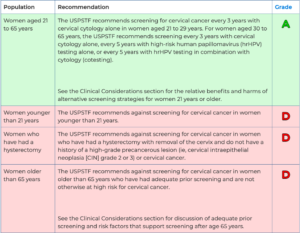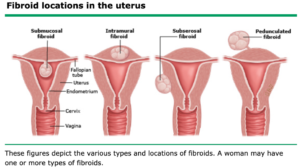Cervical cancer screening is performed using cervical cytology (Pap test) or a human papillomavirus (HPV) test, or a combination of the two tests.
Recommendations from United States Preventative Services Task Force

*Cervical cancer screening is not recommended in patients under 21 years of age because of the high prevalence of transient HPV infection( which lasts no more than 12 year) among adolescents and young adults.
Source: https://www.uspreventiveservicestaskforce.org/uspstf/recommendation/cervical-cancer-screening
Uterine Fibroids
Uterine leiomyomas/fibroids/myomas are noncancerous monoclonal( from single cell) tumors arising from the smooth muscle cells and fibroblasts of the myometrium( middle layer of uterine wall consisting of smooth muscle cells).
Types of Fibroids

Uterine leiomyomas are the most common pelvic tumor in women. Some of the causes are as follows:
Race: The incidence rates of fibroids are typically found to be two- to threefold greater in black women than in white women. Also, most white women with symptomatic fibroids are in their 30s or 40s; however, black women develop symptoms on average four to six years younger than white women and may even present with disease in their 20s.
Parity: Having one or more pregnancies extending beyond 20 weeks of gestation decreases the chance of fibroid formation. Also, it was shown in some cohort studies that older age at first birth was also associated with a decreased risk compared with younger age at first birth
Early menarche: Under 10 years old, is associated with an increased risk of developing fibroid
Prenatal exposure to diethylstilbestrol, significant red meat consumption, HTN, in creased glycemic index and alcohol are associated with an increased risk of fibroids,
Symptoms
The majority of uterine fibroids are small and asymptomatic. The following are symptoms classified as heavy or prolonged menstrual bleeding, pelvic pressure/pain, urinary tract or bowel obstruction/constipation, infertility, obstetric complications.
Physical Exam :
On bimanual pelvic examination, an enlarged, mobile uterus with an irregular contour is consistent with a leiomyomatous uterus.
Imaging:
Pelvic ultrasound is the imaging study of choice.Fibroids are seen on ultrasound usually as hypoechoic( darker), well-circumscribed round masses. MRI for location of uterine fibroid.
Treatments: Based off the patients symptoms and if patient is planning on having children.
For patients not desiring fertility:
Isolated Heavy Menstrual Bleeding–can do a hysteroscopic fibroid resection( which can be done outpatient), if the fibroids are in an appropriate anatomic location, or medical treatment aimed at reducing HMB for those with fibroids in locations not amenable to hysteroscopic resection.
Medical Management:
- Estrogen-progestin contraceptives – most common medical therapy utilized by individuals with HMB and fibroids, especially those who desire contraception
- Progestin-releasing intrauterine devices (IUDs) – like levonorgestrel (LNG)-releasing IUDs
- Tranexamic acid is a nonhormonal oral medication that can be taken during menses or during the heavy days of menses.
2nd Tier:
Patients with bulk or pressure sx’s are given 2nd tier options like (GnRH) agonists and antagonists. GnRH agonist have side effects which limits the use.
GnRH Antagonist
Relugolix – Relugolix is approved in Japan for treatment of uterine fibroids (40 mg oral daily dose
Elagolix— but it is being evaluated for the treatment of fibroid-related HMB
3rd Tier:
- Focused ultrasound surgery
- Endometrial ablation
- Traditional surgery hysterectomy( remove uterus) and myomectomy for patients who do not desire future fertility and have persistent fibroid-related symptoms despite the therapies
For patients not desiring fertility:
- Hysteroscopic myomectomy for submucosal fibroids FIGO type 1, 2, and 3.
- Abdominal myomectomy via either laparoscopy (with or without robotic assistance) or an open incision.
- Open abdominal myomectomy – For patients with more numerous and/or larger fibroids.
Source: https://www-uptodate-com.york.ezproxy.cuny.edu/contents/uterine-fibroids-leiomyomas-treatment-overview?search=uterine%20fibroid&source=search_result&selectedTitle=1~150&usage_type=default&display_rank=1


